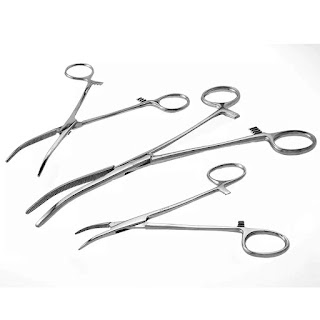Artery Forceps are used in many surgical procedures to control bleeding. Their main use is blocking the flow of blood and closing the blood vessels. They are also used to hold the tissue and skin.
They are also called hemostatic forceps, hemostatic clamp, arterial forceps.
Classification of artery forceps
- Small or Mosquito
- Medium
- Large or Pedicular
Each can be a straight type or curved type of instrument.
Artery forceps can also be classified as:-
- Toothed type e.g., Kocher's artery forceps, Lane's artery forceps.
- Non-toothed type, e.g., Crile's artery forceps, Spencer-Wells artery forceps, Halstead's artery forceps, Rochester Pean's artery forceps.
Common features of artery forceps
- It is a light but strong instrument.
- The inner margins of the blades are serrated and on closure the blades are well apposed, leaving no gas in between.
- The blades are conical and blunt.
- The blades can be held together by means of a catch-lock.
Uses of Artery Forceps
- As a haemostat.
- As a pedicular clamp for spleen and kidney.
- To crush the base of the appendix during appendectomy.
- To hold the cut edges of fascia, aponeurosis, peritoneum, after incising them, during dissection or for closure after surgery.
- To open up the abscess cavity, breaking all the loculi and causing free bleeding (Hilton's Method)
- To hold needles for suturing, as a substitute for a needle holder.
- To hold free ends of tension sutures as they are passed on after the other without tying, till the requisite number of sutures are given.
- Similarly, to hold the free ends of sutures left long during intestinal anastomosis, till they are finally tied off.
- To hold the tape of the abdominal packs to the drapes, thereby ending any chance of leaving the abdominal pack inside undetected.
Mosquito Artery Forceps
This forceps is very small in size and has relatively pointed tips.
Uses:
- It is used for holding small pointed bleeding sites. It stops bleeding by crushing the bleeder.
- It can be used for any of the uses mentioned above.
- To hold gauze-pellets for blunt dissection (Peanut).
Crile Haemostatic Forceps
Crile haemostatic forceps is used for occluding bleeders before cauterization or ligation. It may also be used for
blunt dissection when separating planes and tissues.
It is either curved or straight clamp with horizontal serrations that run the complete length of
the jaws.
The curved Crile is the most widely used clamp in all speciality areas.
Kelly Haemostatic Forceps
Kelly forceps is used for occluding bleeders before cauterization or ligation.
Kelly clamp is either curved or straight with horizontal serrations that run about half the length
of the jaws.
Rochester-Pean Haemostatic Forceps
Rochester-Pean hemostatic forceps is used for occluding larger blood vessels and tissue before ligation, usually in a
deeper wound or on heavier tissue.
It is either curved or straight clamp that has heavier broader jaws with horizontal serrations
that run the length of the jaws.
Spencer Wells Haemostatic Forceps
Spencer Wells forceps is used during surgery to compress the Artery, clamp, and seal small Blood Vessels or hold the Artery out of the way.
It has gripping jaws and finely serrated blades. Moreover,
Kocher's Haemostatic Forceps
It is a toothed variety of haemostatic forceps, having a single sharp tooth at its tip. The rest of the features are same as mentioned above.
Uses:
- It is specifically used to hold the retracting cut ends of the vessels in tough fibrous tissues such as in palms, soles and scalp.
- To catch hold of perforating vessels in Radical Mastectomy.
- To hold gauze-pellets for blunt dissection.
- To hold superficial thyroid vessels - the original use of this instrument.
- To hold rib during rib resection.
- To cause artificial rupture of gestational membranes.
- To hold the incised peritoneal layer and tough fibrous fascia of palms and soles.
Negus Artery Forceps
Uses:
It is used to ligate the vessels present at depth. The bleeder is held with a straight artery forceps and then Negus curved artery forceps is used to ligate it, e.g., cystic artery during cholecystectomy.
Features:
- It is a stout, long jawed forceps.
- The jaws are bent in the form of a hook.
- The inner margins of the jaws are transversely serrated.









Comments
Post a Comment